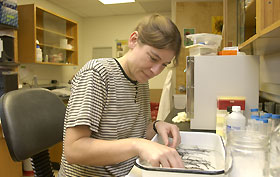|
This is an archived article.
For the latest news, go to the
Advance Homepage
For more archives, go to the Advance Archive/Search Page. | ||
|
Biologist Seeks Clues To Evolution As a youngster growing up in Illinois, Elizabeth Jockusch collected insects and shells and enjoyed splashing around in the local creek and seeing what creatures lived there.
As an assistant professor in UConn's Department of Ecology and Evolutionary Biology, Jockusch behaves in much the same way, except that now her focus is largely limited to two specific types of creatures: salamanders and insects. The fascination with living things and how they became as they are today has been a lifelong passion for Jockusch, who is in her fifth year at UConn and spends her days teaching evolution to undergraduates and conducting research with graduate students. Her work with insects strives to explain where insect wings came from. What evolutionary steppingstones bridged the gap between insects with no wings, and winged ones? Did today's insects have an ancestor with vestigial wings, or did wings develop from leg parts, for example? Her insect subjects include flour beetles, grasshoppers, and a relative of the silverfish, a wingless pest called the firebrat. She and one of her students also head to Connecticut's best-known trout stream, the Housatonic, to collect mayflies when they swarm off the river. Jockusch is interested in what happened hundreds of millions of years ago, as well as why it happened, and the two questions inevitably cross paths. She notes that being able to fly would be an advantage to most insects, but that not all insect lineages evolved the ability to fly. While natural selection can explain why wings were favored once they originated, it does not explain what genetic predispositions, mutations, or other factors led some to fly and some to crawl. That question is a focal point of Jockusch's research. The salamander research focuses on speciation - the origins of different species, their distribution across a landscape, and where one species leaves off and another begins. Jockusch's research on slender or worm salamanders, which occur throughout California, has expanded the body of knowledge about these creatures. "In the 1950s, only two species were recognized in this group. By the time I got involved with them, there were eight. Now we're up to 19, and it's mostly not because we discovered new ones. Rather, we went beyond their appearance - they look identical - and sequenced DNA to show how different each really was," she says. The DNA is taken from the tip of the salamander's tail, which grows back. In addition to DNA, the current tools of an evolutionary biologist's trade include fossils and museum specimens that can be compared to today's animals. The goal of research like Jockusch's is to fill in gaps in the understanding of how various animals evolved. As this occurs, it becomes possible to draw conclusions about the relationships between species - such as lobsters and spiders - that at first glance might not seem to have much in common. "Evolution ties everything together," she says. For Jockusch, the ultimate reward her work offers is the possibility to discover and be able to state with conviction something that no one else on the planet has been able to do or say before. "Science is exciting. It's exciting to look at things in the world and learn things nobody else has," she says. "A lot of what I do is tedious or repetitive, but I get to break new ground too." Despite viewing insects in ways the average person would never consider, Jockusch also views them in much the same way a lot of the time. A monarch butterfly is still a creature of beauty to her, and a honeybee is a benign and beneficial insect. And the firebrats she collects in the boiler room of the building where she teaches are pests. Their origins may be fascinating, but she still finds them unwelcome in human habitats. Jockusch, who also is an accomplished pianist, has a Steinway at home; but the challenge of trying to unravel vexing questions about evolution proved a stronger draw for her career. She is not deterred by the fact that answers in her field are often as elusive as some of the skirring insects she studies. "With the insect wing question, there will probably always be debate unless the right fossils come along," she says. "But with some of the salamanders we'll have definitive answers." Her work with both insects and salamanders has been detailed in many publications that explore such subjects as the evolution of insect wings; diversification of insect appendages; and techniques for acquiring and raising salamander eggs. |

